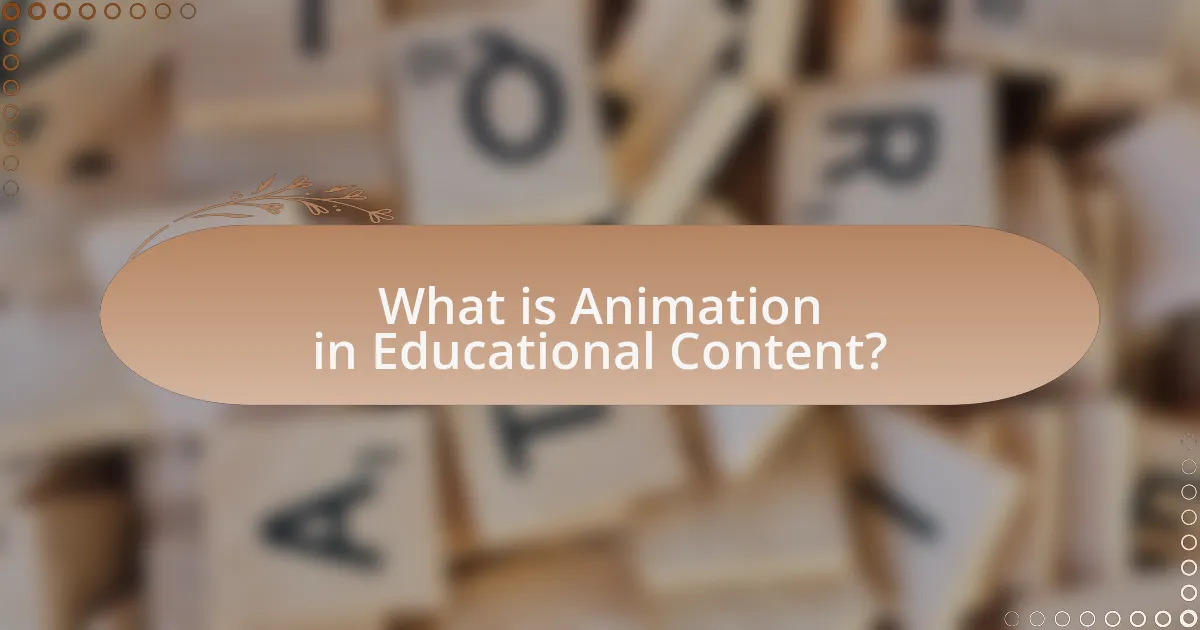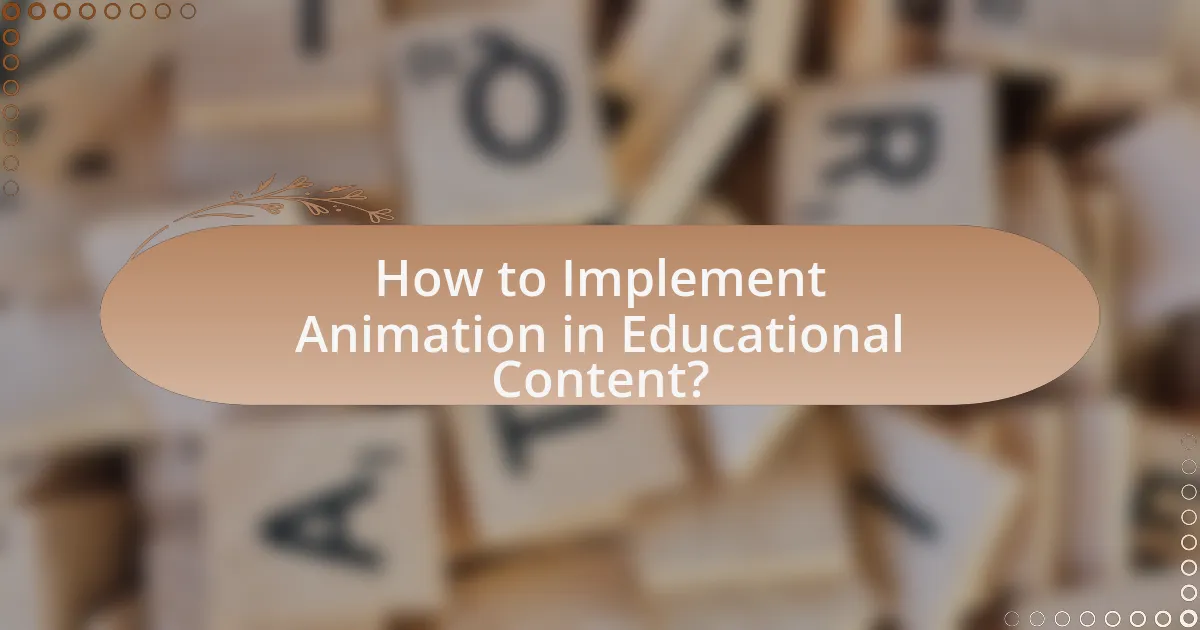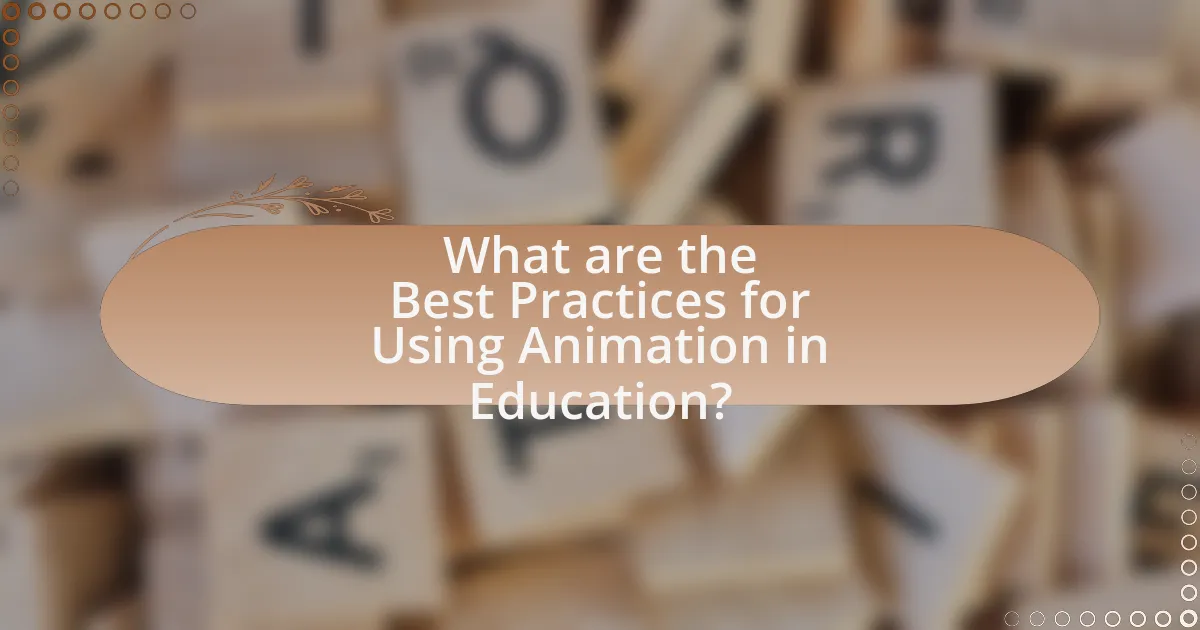Animation in educational content is the use of moving images and visual effects to enhance learning experiences by simplifying complex concepts and maintaining learner engagement. Research shows that animated content can significantly improve retention and understanding, with interactive animations being particularly effective. This article explores the various types of animations, their impact on different learning styles, and the importance of animation in modern education. It also provides practical guidance on implementing animation in educational settings, including tools for creation, best practices, and common pitfalls to avoid, ensuring that animations effectively support educational objectives and enhance learner outcomes.

What is Animation in Educational Content?
Animation in educational content refers to the use of moving images and visual effects to convey information and enhance learning experiences. This method engages learners by simplifying complex concepts, making abstract ideas more tangible, and maintaining attention through dynamic visuals. Research indicates that animated content can improve retention and understanding, as evidenced by a study published in the Journal of Educational Psychology, which found that students who learned through animation scored higher on assessments compared to those who received traditional instruction.
How does animation enhance learning experiences?
Animation enhances learning experiences by making complex concepts more accessible and engaging. It simplifies information through visual representation, allowing learners to grasp difficult subjects more easily. Research indicates that animated content can improve retention rates; for instance, a study published in the Journal of Educational Psychology found that students who learned through animation scored significantly higher on retention tests compared to those who learned through static images. Additionally, animation captures attention and maintains interest, which is crucial for effective learning. By combining visual and auditory stimuli, animation caters to various learning styles, further enhancing comprehension and engagement.
What types of animations are most effective in education?
Interactive animations are the most effective types of animations in education. These animations engage learners by allowing them to manipulate elements, which enhances understanding and retention of complex concepts. Research indicates that interactive animations can improve learning outcomes by up to 50% compared to static images or text alone, as they cater to various learning styles and promote active participation. Additionally, studies show that animations that illustrate processes or transformations, such as simulations in science or math, significantly aid in conceptual understanding, making abstract ideas more tangible for students.
How does animation cater to different learning styles?
Animation caters to different learning styles by engaging visual, auditory, and kinesthetic learners effectively. Visual learners benefit from animated graphics and illustrations that simplify complex concepts, making information easier to digest. Auditory learners gain from accompanying soundtracks and voiceovers that reinforce the material, enhancing retention through auditory stimulation. Kinesthetic learners are engaged through interactive animations that allow them to manipulate elements, fostering a hands-on approach to learning. Research indicates that multimedia learning, which includes animation, can improve understanding and retention by up to 50% compared to traditional methods, as shown in studies by Mayer (2001) on multimedia learning principles.
Why is animation important in modern education?
Animation is important in modern education because it enhances engagement and improves retention of information. Studies show that visual learning, which includes animation, can increase information retention rates by up to 65% compared to traditional teaching methods. This is particularly effective in explaining complex concepts, as animations can simplify and illustrate processes that are difficult to convey through text alone. Furthermore, research published in the Journal of Educational Psychology indicates that students who learn through animated content demonstrate higher motivation and interest in the subject matter, leading to better academic performance.
What research supports the use of animation in learning?
Research supports the use of animation in learning by demonstrating its effectiveness in enhancing comprehension and retention. For instance, a study by Mayer and Moreno (2003) published in the Educational Psychologist found that students who learned through animated explanations performed better on transfer tests compared to those who received static images. Additionally, a meta-analysis by Hegarty and Just (1993) in the Journal of Educational Psychology indicated that animations can facilitate understanding of complex processes by providing dynamic visual representations. These findings underscore the value of animation as a tool for improving educational outcomes.
How does animation improve information retention?
Animation improves information retention by engaging multiple cognitive processes, which enhances understanding and memory recall. Research indicates that animated visuals can capture attention more effectively than static images, leading to better retention of information. For instance, a study published in the journal “Educational Psychology” by Hegarty and Just (1993) found that students who learned from animated diagrams performed better on retention tests compared to those who learned from static diagrams. This is attributed to the dual-coding theory, which suggests that information presented in both visual and verbal formats is more likely to be remembered.

How to Implement Animation in Educational Content?
To implement animation in educational content, educators should integrate animated visuals that complement and clarify the subject matter. This can be achieved by using software tools like Adobe Animate or Powtoon to create engaging animations that illustrate complex concepts, making them easier for learners to understand. Research indicates that animations can enhance retention and comprehension; for instance, a study published in the Journal of Educational Psychology found that students who learned with animated content scored significantly higher on assessments compared to those who used static images. Therefore, incorporating animations effectively can lead to improved educational outcomes.
What tools and software are available for creating educational animations?
Tools and software available for creating educational animations include Adobe Animate, Vyond, Powtoon, and Blender. Adobe Animate is widely used for creating vector animations and interactive content, making it suitable for educational purposes. Vyond offers a user-friendly platform for creating animated videos with customizable characters and templates, ideal for educators. Powtoon provides a simple interface for producing animated presentations and videos, enhancing engagement in educational settings. Blender is a powerful open-source 3D animation software that allows for complex animations, suitable for advanced educational projects. Each of these tools has specific features that cater to different aspects of educational animation, ensuring a variety of options for creators.
How do you choose the right tool for your needs?
To choose the right tool for your needs in enhancing educational content with animation, first assess your specific educational objectives and audience requirements. Identifying whether you need tools for creating simple animations, interactive content, or complex visualizations will guide your selection. For instance, tools like Adobe Animate are suitable for advanced animations, while platforms like Powtoon or Animaker cater to users seeking user-friendly interfaces for basic animations. Research indicates that 70% of educators find that using animation increases student engagement, highlighting the importance of selecting a tool that aligns with your goals and enhances learning outcomes.
What are the key features to look for in animation software?
Key features to look for in animation software include user-friendly interface, robust animation tools, compatibility with various file formats, and strong support for audio integration. A user-friendly interface allows educators to create animations without extensive technical knowledge, enhancing accessibility. Robust animation tools, such as keyframe animation and motion paths, enable the creation of dynamic and engaging content. Compatibility with various file formats ensures that animations can be easily shared and integrated into different platforms. Strong audio integration support allows for the synchronization of sound effects and voiceovers, which is crucial for educational content. These features collectively enhance the effectiveness of animations in educational settings, making complex concepts easier to understand and retain.
What steps should be followed to create effective educational animations?
To create effective educational animations, follow these steps: first, define clear learning objectives that outline what the animation aims to teach. Next, develop a script that conveys the content in a concise and engaging manner, ensuring it aligns with the learning objectives. After that, create a storyboard to visualize the flow of the animation, which helps in organizing scenes and transitions effectively. Then, choose appropriate animation software that suits your skill level and project requirements. Following this, design visuals that are simple yet appealing, using colors and graphics that enhance understanding rather than distract. Finally, incorporate audio elements, such as narration and sound effects, to reinforce the message and maintain viewer engagement. Each of these steps is essential for producing animations that effectively communicate educational content and facilitate learning.
How do you define the learning objectives for your animation?
To define the learning objectives for animation, I first identify the key concepts and skills that the animation aims to teach. This involves analyzing the target audience’s needs and aligning the objectives with educational standards or curriculum goals. For instance, if the animation is designed to explain a scientific principle, the objective might be to ensure that learners can describe the principle and apply it in real-world scenarios. Research indicates that clear learning objectives enhance engagement and retention, as they provide a roadmap for both the creator and the audience, ensuring that the content is focused and relevant.
What is the process of storyboarding for educational animations?
The process of storyboarding for educational animations involves creating a visual plan that outlines each scene and its corresponding elements. This process typically begins with defining the educational objectives, followed by sketching scenes that represent key concepts, dialogue, and actions. Each storyboard frame serves as a blueprint, detailing the sequence of events and visual transitions, ensuring that the educational message is conveyed effectively.
Additionally, storyboards often include notes on timing, narration, and sound effects, which are crucial for enhancing viewer engagement and comprehension. This structured approach allows creators to visualize the flow of the animation, making it easier to identify potential issues and make necessary adjustments before production begins.

What are the Best Practices for Using Animation in Education?
The best practices for using animation in education include ensuring clarity, relevance, and engagement. Clarity is achieved by using animations that simplify complex concepts, making them easier for students to understand. For instance, animations that visually represent scientific processes can enhance comprehension. Relevance involves aligning animations with educational objectives, ensuring they support the learning goals rather than distract from them. Engaging animations capture students’ attention and maintain their interest, which can lead to improved retention of information. Research indicates that students who learn with animations perform better on assessments compared to those who learn with static images, highlighting the effectiveness of well-designed educational animations.
How can you ensure animations are accessible to all learners?
To ensure animations are accessible to all learners, incorporate features such as captions, audio descriptions, and adjustable playback speeds. Captions provide text for spoken content, making it easier for learners with hearing impairments to follow along. Audio descriptions offer a verbal narration of visual elements, aiding those with visual impairments. Additionally, allowing users to adjust playback speeds accommodates different learning paces, enhancing comprehension. Research indicates that these accessibility features significantly improve learning outcomes for diverse learner populations, as highlighted in the study “Universal Design for Learning: Theory and Practice” by Meyer, Rose, and Gordon.
What guidelines should be followed for color and design in animations?
Guidelines for color and design in animations include using a limited color palette, ensuring high contrast for readability, and maintaining consistency in design elements. A limited color palette helps to avoid overwhelming viewers, while high contrast between text and background enhances legibility, which is crucial for educational content. Consistency in design elements, such as fonts and icons, aids in creating a cohesive visual experience that supports learning. Research indicates that consistent design improves user comprehension and retention, making these guidelines essential for effective educational animations.
How can you incorporate feedback to improve animations?
Incorporating feedback to improve animations involves actively seeking input from viewers and stakeholders, then implementing changes based on that feedback. For instance, animators can conduct surveys or focus groups to gather opinions on clarity, engagement, and visual appeal. Research shows that iterative design processes, which include feedback loops, lead to higher user satisfaction and effectiveness in educational content. A study by the University of Southern California found that animations refined through user feedback resulted in a 30% increase in viewer retention and understanding. By systematically analyzing this feedback and making targeted adjustments, animators can enhance the educational impact of their work.
What common pitfalls should be avoided when using animation in education?
Common pitfalls to avoid when using animation in education include overloading animations with excessive detail, which can distract learners from the core message. Research indicates that animations should be simple and focused to enhance understanding; for instance, a study by Mayer (2009) highlights that cognitive overload can hinder learning outcomes. Additionally, failing to align animations with learning objectives can lead to confusion, as animations must support the educational goals rather than serve as mere embellishments. Lastly, neglecting to consider the diverse learning styles of students can limit the effectiveness of animations, as not all learners process visual information in the same way.
How can overuse of animation detract from learning?
Overuse of animation can detract from learning by overwhelming learners with excessive visual stimuli, which can lead to cognitive overload. Cognitive overload occurs when the amount of information presented exceeds the learner’s processing capacity, making it difficult to retain and understand key concepts. Research by Sweller (1988) on Cognitive Load Theory indicates that when learners are bombarded with too many animations, their ability to focus on essential information diminishes, resulting in decreased comprehension and retention. Additionally, animations that are not directly relevant to the learning objectives can distract learners, diverting their attention away from critical content and hindering effective learning outcomes.
What are the risks of using low-quality animations?
Using low-quality animations poses several risks, including decreased engagement, miscommunication of information, and potential damage to credibility. Low-quality animations can distract viewers rather than enhance understanding, leading to reduced retention of educational content. Research indicates that poorly designed visuals can confuse learners, resulting in misunderstandings of key concepts. Furthermore, low-quality animations may reflect poorly on the institution or brand, undermining trust and authority in educational settings. For instance, a study published in the Journal of Educational Psychology found that high-quality visuals significantly improved learning outcomes compared to low-quality alternatives, highlighting the importance of animation quality in educational contexts.
What are some practical tips for effectively using animation in educational content?
To effectively use animation in educational content, focus on clarity, engagement, and relevance. Clear animations simplify complex concepts, making them easier to understand; for example, using animated diagrams can illustrate processes that are difficult to convey through text alone. Engaging animations capture learners’ attention, which is crucial for retention; studies show that visual stimuli can enhance memory recall by up to 65%. Additionally, ensure that animations are relevant to the content, as irrelevant visuals can distract rather than educate. By aligning animations with learning objectives, educators can enhance comprehension and retention, ultimately improving educational outcomes.